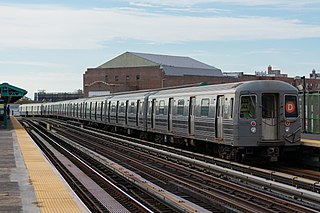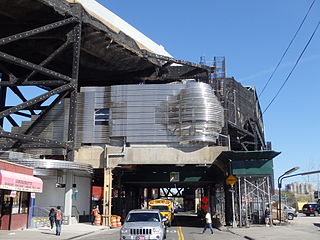The IND Culver Line is a rapid transit line of the B Division of the New York City Subway, extending from Downtown Brooklyn south to Coney Island, Brooklyn, New York City, United States. The local tracks of the Culver Line are served by the F service, as well as the G between Bergen Street and Church Avenue. The express tracks north of Church Avenue are used by the <F> train during rush hours in the peak direction. The peak-direction express track between Ditmas Avenue and Avenue X has not seen regular service since 1987.
The IND Sixth Avenue Line is a rapid transit line of the B Division of the New York City Subway in the United States. It runs mainly under Sixth Avenue in Manhattan, and continues south to Brooklyn. The B, D, F, and M trains, which use the Sixth Avenue Line through Midtown Manhattan, are colored orange. The B and D trains use the express tracks, while the F, <F> and M trains use the local tracks.

The D Sixth Avenue Express is a rapid transit service in the B Division of the New York City Subway. Its route emblem, or "bullet", is colored orange, since it uses the IND Sixth Avenue Line in Manhattan.

The F and <F> Queens Boulevard Express/Sixth Avenue Local are two rapid transit services in the B Division of the New York City Subway. Their route bullets are colored orange, since they use and are part of the IND Sixth Avenue Line in Manhattan.

The 34th Street–Herald Square station is an underground station complex on the BMT Broadway Line and the IND Sixth Avenue Line of the New York City Subway. It is located at Herald Square in Midtown Manhattan where 34th Street, Broadway and Sixth Avenue intersect, and is served by the D, F, N, and Q trains at all times; the R train at all times except late nights; the B, M, and W trains on weekdays; and the <F> train during rush hours in the peak direction.

The Church Avenue station is an express station on the IND Culver Line of the New York City Subway. Located at Church and McDonald Avenues in Kensington, Brooklyn, it is served by the F and G trains at all times, and by the <F> train during rush hours in the peak direction.

The Carroll Street station is a local station on the IND Culver Line of the New York City Subway, located in the neighborhood of Carroll Gardens, Brooklyn, at Carroll and Smith Streets. It is served by the F and G trains at all times.

The Seventh Avenue station is an express station on the IND Culver Line of the New York City Subway, located at Seventh Avenue and Ninth Street in the Park Slope neighborhood of Brooklyn. It is served by the F and G trains at all times, and by the <F> train during rush hours in the peak direction.

The 145th Street station is a bi-level express station on the IND Eighth Avenue and Concourse lines of the New York City Subway, located at the intersection of 145th Street and St. Nicholas Avenue in Harlem and Hamilton Heights, Manhattan. It is served by the A and D trains at all times, by the C train at all times except late nights, and by the B train on weekdays only.

The Smith–Ninth Streets station is a local station on the IND Culver Line of the New York City Subway. It is located over the Gowanus Canal near the intersection of Smith and Ninth Streets in Gowanus, Brooklyn, and is served by the F and G trains at all times. The station is 87.5 feet (26.7 m) above ground level and was the highest rapid transit station in the world when it was built.

The West Fourth Street–Washington Square station is an express station and transfer stop on the IND Sixth Avenue and IND Eighth Avenue Lines of the New York City Subway, located at the intersection of West Fourth Street and Sixth Avenue in Greenwich Village, Manhattan. It is served by the A, D, E, and F trains at all times; the B and M trains on weekdays; the C train at all times except late nights; and the <F> train during rush hours in the peak direction.

The West Eighth Street–New York Aquarium station is a New York City Subway station, located on the BMT Brighton Line and IND Culver Line in the Coney Island neighborhood of Brooklyn. The station is located over the private right-of-way of the defunct New York and Coney Island Railroad north of Surf Avenue, running easterly from West 8th Street. It is served by the F and Q trains at all times, and by the <F> train during rush hours in the peak direction. This station is geographically the southernmost station in the entire New York City Subway system.

The 15th Street–Prospect Park station is a local station on the IND Culver Line of the New York City Subway. Located at 15th Street east of Prospect Park West in the Windsor Terrace and Park Slope neighborhoods in Brooklyn, it is served by the F and G trains at all times.

The Fort Hamilton Parkway station is a local station on the IND Culver Line of the New York City Subway. It is served by the F and G trains at all times.

The Jackson Heights–Roosevelt Avenue/74th Street station is a New York City Subway station complex served by the IRT Flushing Line and the IND Queens Boulevard Line. Located at the triangle of 74th Street, Broadway, and Roosevelt Avenue in Jackson Heights, Queens, it is served by the 7, E, and F trains at all times; the R train at all times except late nights; the M train weekdays during the day; and the <F> train during rush hours in the reverse peak direction.

The 65th Street station is a local station on the IND Queens Boulevard Line of the New York City Subway, located at the intersection of 65th Street and Broadway in Queens. It is served by the M train on weekdays, the R train at all times except nights, and the E and F trains at night. The station opened on August 19, 1933, as part of the Independent Subway System's Queens Boulevard Line.

The 36th Street station is a local station on the IND Queens Boulevard Line of the New York City Subway. Located at the intersection of 36th Street and Northern Boulevard in Queens, it is served by the M train on weekdays, the R train at all times except nights, and the E and F trains at night. The <F> train skips this station when it operates.

The Fourth Avenue/Ninth Street station is a New York City Subway station complex shared by the elevated IND Culver Line and the underground BMT Fourth Avenue Line. It is located at the intersection of Ninth Street and Fourth Avenue in Park Slope, Brooklyn and served by the:

The Fulton Street station is a major New York City Subway station complex in Lower Manhattan. It consists of four linked stations on the IND Eighth Avenue Line, the IRT Lexington Avenue Line, the BMT Nassau Street Line and the IRT Broadway–Seventh Avenue Line. The complex is served by the 2, 4, A, and J trains at all times. The 3, 5, and C trains stop here at all times except late nights, and the Z stops during rush hours in the peak direction.

The Jay Street–MetroTech station is a New York City Subway station complex on the IND Fulton Street, IND Culver, and BMT Fourth Avenue lines. The complex is located in the vicinity of MetroTech Center in Downtown Brooklyn. It is served by the A, F, and R trains at all times; the C train at all times except late nights; the N train during late nights only; and a few rush-hour W and <F> trains in the peak direction.
























